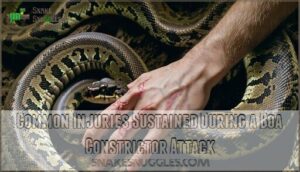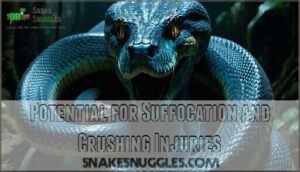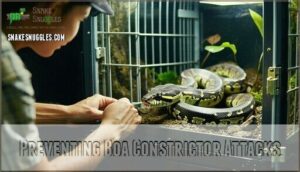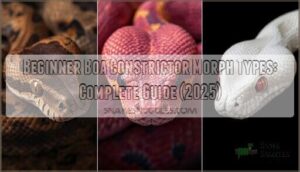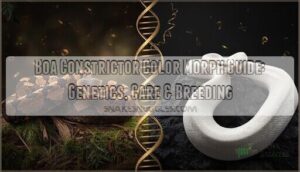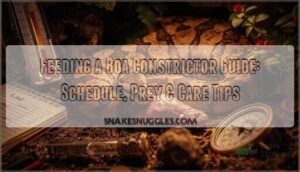This site is supported by our readers. We may earn a commission, at no cost to you, if you purchase through links.

Instead, grab the snake’s head and tail simultaneously, then pull them apart with firm pressure. These powerful constrictors squeeze tighter when you struggle against their middle sections.
You’ve got roughly four minutes before circulation becomes critical. Attack the head area behind the skull while someone else handles the tail end.
Boa constrictors rarely attack humans unprovoked, but defensive strikes happen during improper handling or when they’re stressed. Understanding their body language and knowing the right escape techniques can mean the difference between a close call and tragedy.
Table Of Contents
- Key Takeaways
- Boa Constrictors and Aggression
- Anatomy of a Boa Constrictor Attack
- Boa Constrictor Attack Injuries
- First Aid for a Boa Constrictor Attack
- Preventing Boa Constrictor Attacks
- Frequently Asked Questions (FAQs)
- Have boa constrictor killed anyone?
- Is a boa constrictor aggressive?
- How to stop a boa constrictor attack?
- What happens if a boa constrictor bites you?
- Will a boa constrictor attack a human?
- What to do if a boa constrictor bites you?
- Do boa constrictors bite people’s faces?
- What happens if you hit a boa constrictor?
- Are boa constrictors venomous?
- How did the woman acquire her snakes?
- Conclusion
Key Takeaways
- Don’t panic or fight the middle coils during an attack – instead, grab the snake’s head and tail simultaneously and pull them apart with firm pressure to break the constriction grip.
- You’ve got roughly four minutes before circulation becomes critical, so act quickly but calmly to avoid the snake’s hydraulic-like squeezing mechanism that tightens when you struggle.
- Boa constrictors aren’t naturally aggressive and rarely attack humans unprovoked – they typically strike only when they’re stressed, cornered, or improperly handled.
- Create proper housing with adequate space, temperature gradients, and humidity control while learning safe handling techniques to prevent most attacks before they happen, and remember to stay calm in case of an attack to ensure you can apply the right methods to escape the snake’s grip.
Boa Constrictors and Aggression
You’ll find that boa constrictors aren’t naturally aggressive snakes and rarely attack humans without cause.
Most boa constrictors are gentle giants that only strike when they feel cornered or threatened.
They typically strike only when they feel threatened, cornered, or stressed by improper handling or unfamiliar situations, which makes them rarely attack unless provoked.
Are Boa Constrictors Aggressive by Nature?
Boa constrictors rarely show innate aggression toward humans.
These powerful snakes are naturally nonaggressive and prefer flight over fight.
Their temperament factors lean toward avoidance rather than confrontation.
Understanding snake behavior helps you stay safe around these magnificent creatures.
Their aggression can be triggered by environmental changes.
Captivity effects on their natural disposition include:
- Reduced stress from hunting pressure
- Increased tolerance to human interaction
- Predictable feeding schedules calming nerves
- Defensive behaviors triggered only when cornered
- Snake temperament remaining generally docile with proper care
Factors That Can Trigger Aggression in Boa Constrictors
Understanding snake aggression triggers helps you stay safe around these powerful reptiles.
Handling mistakes like sudden movements or grabbing incorrectly create stress triggers that spark defensive behavior.
Hunger cues make boas associate you with food, while incorrect handling during shedding or illness activates their protective instincts.
Environmental stress signs include cramped enclosures, wrong temperatures, or unfamiliar scents that provoke attacks.
Proper Handling Techniques to Avoid Provoking Attacks
Mastering safe handling practices keeps you and your boa calm during interactions. Gentle techniques and respecting boundaries prevent defensive strikes.
Follow these essential handling precautions:
- Support the snake’s body weight evenly across your arms
- Move slowly and avoid sudden jerky motions
- Watch for stress signs like hissing or defensive posturing
- Never handle during shedding or feeding times
- Maintain confident, calm energy throughout interactions
Reducing stress through proper snake handling guarantees effective bite prevention and snake safety. For enhanced protection, consider using specialized handling equipment.
Anatomy of a Boa Constrictor Attack
When you’re dealing with a boa constrictor attack, you’ll face a calculated predator that strikes fast and wraps around you with incredible force.
Understanding how these snakes hunt and constrict their prey gives you the knowledge you need to respond effectively and escape their deadly grip.
How Boa Constrictors Hunt and Kill Prey
Now that you understand boa constrictor temperament, let’s examine their predatory behavior.
These serpents master the art of patience, using sophisticated ambush tactics to catch unsuspecting victims.
Their hunting strategy revolves around remaining motionless for hours, perfectly camouflaged in their hunting environment until prey wanders within striking distance.
You’ll witness three distinct phases when observing boa constrictor hunting:
- Detection Phase – Heat-sensing pits locate warm-blooded targets in complete darkness
- Strike Phase – Lightning-fast lunging captures prey with razor-sharp teeth
- Prey Selection – Size assessment determines whether the catch merits energy expenditure
Once secured, the digestive process begins immediately.
Their predatory behavior demonstrates remarkable efficiency, with constriction force applied strategically to subdue victims before swallowing them whole.
They’re sometimes kept as pets to provide natural rodent control in residential areas.
The Coiling and Constriction Process
The coiling process begins lightning-fast after a boa strikes.
Its muscular body wraps around you like a living vice, tightening with surgical precision.
This constriction technique doesn’t crush bones—it cuts off blood flow to essential organs.
Each time you exhale, the snake’s constriction strength increases, creating suffocation risk through circulatory shutdown rather than airway blockage.
Muscle damage occurs as pressure builds.
This methodical prey death strategy explains constrictor behavior: they’re patient killers.
Unlike crushing injuries from blunt force, snake constriction slowly starves your tissues of oxygen until cardiac arrest occurs.
They can exert about one kg/cm² during this process.
Boa Constrictor Attack Injuries
When you’re caught in a boa constrictor’s grip, you’ll face specific injuries that need immediate attention.
The snake’s bite creates puncture wounds while its powerful coils can cause bruising, muscle damage, and dangerous breathing problems.
Common Injuries Sustained During a Boa Constrictor Attack
Three types of snake attack injuries can turn a boa constrictor encounter into a medical emergency. When these powerful serpents strike, their backward-facing teeth create deep puncture wounds that often require stitches.
The coiling action causes laceration risks as the snake’s muscular body drags across your skin. Bruising severity depends on the snake’s size and grip strength. Larger boas can exert crushing force, leading to significant tissue damage.
The real danger lies in circulation issues that develop during constriction. Blood flow restriction causes muscle damage that may not be immediately visible. The snakes are ambush predators, and constricting prey is their common hunting method.
Crushing injuries occur when the snake’s powerful coils compress soft tissue and bones. These injuries include:
- Deep tissue bruising that affects underlying muscles
- Restricted blood flow causing numbness and tingling
- Potential fractures from extreme constriction pressure
Potential for Suffocation and Crushing Injuries
Beyond puncture wounds, boa constrictor attacks create life-threatening scenarios through their constriction technique.
These snakes don’t crush bones—they cut off blood flow and cause breathing impairment.
Each time you exhale, the coils tighten further, leading to suffocation and severe tissue damage.
The constriction mechanics gradually increase pressure, making injury severity depend on how quickly you escape the deadly embrace.
First Aid for a Boa Constrictor Attack
After a boa constrictor attack, you’ll need to act quickly but calmly to remove the snake safely and treat any wounds.
Your immediate focus should be on stopping bleeding from puncture wounds and checking for breathing problems caused by constriction around your chest or neck.
Safely Removing The Snake and Providing Medical Attention
When you’re locked in a boa’s grip, don’t panic.
Professional snake removal requires specific cutting techniques and emergency services contact. Apply pressure to bleeding wounds while monitoring your breathing and circulation issues.
For wound care after the attack, consider using a suitable compression bandage.
Here’s your snake bite first aid survival plan:
- Stay calm – avoid sudden movements that tighten constriction
- Control breathing – maintain steady oxygen flow despite pressure
- Apply pressure – stop bleeding from puncture wounds immediately
- Call professionals – contact emergency services for snake attack survival assistance
Seeking Professional Medical Care for Serious Injuries
Once you’ve freed yourself from the snake’s grip, don’t assume you’re in the clear.
Professional medical care is non-negotiable after any snake attack. Boa constrictor bites carry serious infection risk, while their powerful coils can cause circulation damage and muscle trauma.
What appears minor might involve crush injuries requiring immediate attention. Emergency room doctors can assess snake injuries properly, provide snake attack treatment, and prevent complications like scarring treatment.
Your snake bite needs expert evaluation – always seek snake attack medical care. Bites can also be affected by tooth condition and location, impacting injury severity.
Preventing Boa Constrictor Attacks
You can avoid most boa constrictor attacks by creating proper housing conditions and learning safe handling techniques.
These snakes rarely attack humans, but stress from poor care or incorrect handling can trigger defensive behavior that puts you at risk.
Proper Housing and Enclosure Requirements for Boa Constrictors
Your proper enclosure becomes your first line of defense against attacks.
Size matters – provide enough space for your boa to stretch completely. Install a temperature gradient with basking spots reaching 88-92°F and cool zones at 78-80°F.
Humidity control between 50-60% prevents stress-induced aggression. Choose appropriate substrate choices like cypress mulch for moisture retention.
Environmental enrichment through hiding spots and climbing branches reduces anxiety, creating a calm snake that won’t lash out defensively. Consider adequate habitat dimensions for your boa.
Responsible Ownership and Handling Practices
Safe handling techniques separate responsible owners from risky ones.
Master these fundamentals before bringing your boa home:
- Learn proper snake handling methods through certified training programs
- Design enriched snake enclosures with appropriate temperature gradients and hiding spots
- Maintain consistent feeding schedules to prevent food-related aggression
Veterinary access and public awareness about responsible pet ownership protect both you and your snake.
Frequently Asked Questions (FAQs)
Have boa constrictor killed anyone?
Fatal boa constrictor attacks on humans are extremely rare.
You’ll find very few documented cases of deaths caused by these snakes.
They’re generally docile creatures that prefer avoiding humans rather than attacking them.
Is a boa constrictor aggressive?
Like a coiled spring, boa constrictors aren’t naturally aggressive creatures.
They’re generally docile unless you corner, stress, or mishandle them.
They prefer fleeing over fighting, attacking only when they feel threatened or provoked.
How to stop a boa constrictor attack?
Stay calm and don’t pull away, as this deepens the bite. Wait for the snake to release naturally. If constricted, protect your neck and breathe steadily while seeking immediate help.
What happens if a boa constrictor bites you?
You’ll experience puncture wounds from their sharp teeth, but no venom injection.
The bite creates deep holes that may bleed and hurt substantially.
Clean wounds immediately and seek medical attention to prevent bacterial infection.
Will a boa constrictor attack a human?
Better safe than sorry—boa constrictors rarely attack humans unprovoked.
You’d typically face defensive behavior only if you corner, surprise, or mishandle them.
These docile snakes prefer fleeing over fighting when encountering people, and it’s worth noting that they are generally safe.
What to do if a boa constrictor bites you?
Remain calm and don’t pull away, as this deepens the bite.
Wait patiently for the snake to release naturally.
Clean the wound thoroughly, apply pressure to stop bleeding, and seek medical attention to prevent infection.
Do boa constrictors bite people’s faces?
Boa constrictors can bite faces if you’re handling them improperly or they feel threatened.
They don’t target faces specifically, but any body part within reach becomes vulnerable when they’re defensive or stressed.
What happens if you hit a boa constrictor?
Hitting a boa constrictor will make it hold on tighter and more aggressively.
You’ll escalate the situation, causing deeper wounds and stronger constriction.
Instead, stay calm and wait for it to release naturally.
Are boa constrictors venomous?
Don’t worry about venom being your enemy here.
Boa constrictors aren’t venomous snakes, they’re constrictors, meaning they squeeze their prey to death rather than injecting toxic substances.
You won’t face poisoning from their bite.
How did the woman acquire her snakes?
I don’t have specific information about how a particular woman acquired her snakes.
You’d need to provide more context about which incident or person you’re referring to for an accurate answer.
Conclusion
While some believe boa constrictor attacks are impossible to survive, proper technique can save your life.
Remember that a boa constrictor attack requires immediate action—grab the head and tail, pull firmly apart, and never fight the middle coils.
You’ve got minutes before circulation becomes critical, so stay calm and act decisively.
Prevention remains your best defense through proper handling, secure enclosures, and understanding snake behavior, and knowledge and preparation are your most powerful tools against these impressive constrictors.
- https://www.nationalgeographic.com/animals/reptiles/facts/boa-constrictor
- https://www.webmd.com/first-aid/snakebite-treatment
- https://animals.howstuffworks.com/snakes/boa-constrictor.htm
- https://www.battlbox.com/blogs/outdoors/do-boa-snakes-bite-understanding-the-behavior-and-risks-of-boa-constrictors
- https://nationalzoo.si.edu/animals/boa-constrictor



